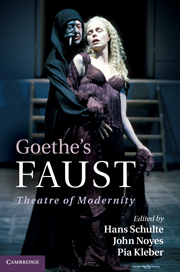Book contents
- Frontmatter
- Contents
- List of illustrations
- List of contributors
- Preface
- List of abbreviations
- Introduction
- PART I MODERNITY
- 1 Faust – today
- 2 Mephisto and the modernization of evil
- 3 Mephisto is the devil – or is he?
- 4 ‘Schwankende Gestalten’: virtuality in Goethe's Faust
- 5 Amnesia and anamnesis in Goethe's Faust
- 6 Magicians of modernity: Cagliostro and Saint-Simon in Goethe's Faust II
- 7 The blind Faust
- 8 From Faust to Harry Potter: discourses of the centaurs
- 9 Mistra and the Peloponnese in Goethe's Faust II
- 10 Goethe and the grotesque: the ‘Classical Walpurgis Night’
- 11 Re-defining classicism: antiquity in Faust II under the sign of the Medusa
- 12 Diabolical entrapment: Mephisto, the angels and the homoerotic in Goethe's Faust II
- PART II THEATRE
- Select bibliography
- Index
4 - ‘Schwankende Gestalten’: virtuality in Goethe's Faust
Published online by Cambridge University Press: 01 June 2011
- Frontmatter
- Contents
- List of illustrations
- List of contributors
- Preface
- List of abbreviations
- Introduction
- PART I MODERNITY
- 1 Faust – today
- 2 Mephisto and the modernization of evil
- 3 Mephisto is the devil – or is he?
- 4 ‘Schwankende Gestalten’: virtuality in Goethe's Faust
- 5 Amnesia and anamnesis in Goethe's Faust
- 6 Magicians of modernity: Cagliostro and Saint-Simon in Goethe's Faust II
- 7 The blind Faust
- 8 From Faust to Harry Potter: discourses of the centaurs
- 9 Mistra and the Peloponnese in Goethe's Faust II
- 10 Goethe and the grotesque: the ‘Classical Walpurgis Night’
- 11 Re-defining classicism: antiquity in Faust II under the sign of the Medusa
- 12 Diabolical entrapment: Mephisto, the angels and the homoerotic in Goethe's Faust II
- PART II THEATRE
- Select bibliography
- Index
Summary
Ask Goethe whether you should put Faust on the stage: he will tell you flatly ‘No!’ He never supported efforts to do so, even though readers and theatre people urged him to stage the piece. When the actor Pius Alexander Wolff and Goethe's adlatus Friedrich Wilhelm Riemer planned a representation in Weimar around 1810, Goethe was angry, saying that if he had wanted, he could have staged it himself. Later he described his attitude towards it as ‘passive, if not suffering’. Finally he consented to draw sketches for some scenes in Part i and revise the stage version, adding lines here and there in order to stress the operatic character which Wolff had intended (FT 582–90). When, in 1829, Weimar and Leipzig rehearsed for a representation of a revised version of Part i, Goethe contributed a chorus for the ‘Study 2’ scene and a final chorus for the ‘Prison’ scene (FT 591 ff.), again to enhance the operatic character which he always had in mind. We think of the multitude of musical inlays in the text, but also of his remark that only Mozart could have set the play to music, and that after his death only Meyerbeer was capable of rendering its more terrifying aspects. He consented to train the actor LaRoche to portray Mephistopheles; indeed, LaRoche confessed that each gesture, each step, each grimace and each word came from Goethe.
- Type
- Chapter
- Information
- Goethe's FaustTheatre of Modernity, pp. 54 - 67Publisher: Cambridge University PressPrint publication year: 2011
- 2
- Cited by



